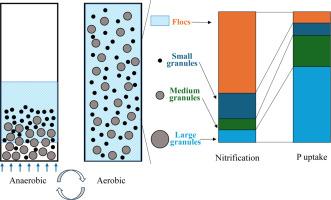颗粒和絮凝体在好氧颗粒污泥过程中的不同作用
IF 12.4
1区 环境科学与生态学
Q1 ENGINEERING, ENVIRONMENTAL
引用次数: 0
摘要
好氧颗粒污泥(AGS)是一种创新、高效的污水处理生物技术,在世界范围内已成功应用。全面的城市AGS系统通常包含颗粒污泥(颗粒)和絮凝污泥(絮凝体)。对颗粒和絮凝体组分不同作用的研究有限。本研究采用实验室规模的AGS反应器,以复杂的合成废水为原料,模拟全尺寸的AGS系统,研究颗粒和絮凝体的不同作用。实验反应器实现了颗粒与絮凝体共存,絮凝体质量分数为17%。对不同粒径组分的脱碳、脱氮和除磷活性进行了评价和比较:絮凝体(FL; <0.2mm)、小颗粒(SG; 0.2 ~ 1.0mm)、中颗粒(MG; 1.0 ~ 2.0mm)和大颗粒(LG; >2.0mm)。在饲喂过程中,大颗粒和中颗粒比小颗粒和絮凝体对底物的吸收更多,这是由于它们优先获得底物。在好氧转化中,絮凝体和小颗粒具有较高的生物量比硝化速率,而中颗粒和大颗粒具有较高的磷吸收和反硝化能力。此外,大颗粒和中颗粒的氧传质限制较大,限制了它们的硝化能力。利用宏基因组学和宏蛋白质组学进行了不同大小组分的微生物群落分析,显示了颗粒和絮凝体中不同的群落。颗粒中含有高丰度的聚磷蓄积菌(Candidatus Accumulibacter, PAO)和糖原蓄积菌(Candidatus Competibacter, GAO)。絮凝体中亚硝基单胞菌(氨氧化菌,AOB)和四胞菌(发酵型PAO)丰度高,积累钙杆菌(Ca. Accumulibacter)丰度低。在实验室反应器中,微生物活性和微生物群落在污泥大小馏分上的分布与全尺寸AGS系统相似,表明该实验室设置可以模拟全尺寸系统,可用于未来的研究。总之,本研究强调了保持不同粒径和絮凝体之间良好平衡以优化营养物去除的重要性。本文章由计算机程序翻译,如有差异,请以英文原文为准。

Distinct roles of granules and flocs in aerobic granular sludge processes
Aerobic Granular Sludge (AGS) is an innovative and efficient biotechnology for wastewater treatment and is successfully applied on full-scale worldwide. Full-scale municipal AGS systems typically contain both granular sludge (granules) and flocculent sludge (flocs). Studies on the different roles of granules and flocs fractions are limited. In this study, a laboratory-scale AGS reactor fed with complex synthetic wastewater was operated to simulate full-scale AGS systems and to study the different roles of granules and flocs. The laboratory reactor achieved a coexistence of granules and flocs with a floc mass fraction of 17%. Activities of different size fractions were evaluated and compared regarding carbon, nitrogen, and phosphorus removal: flocs (FL; <0.2mm), small granules (SG; 0.2∼1.0mm), medium granules (MG; 1.0∼2.0mm), and large granules (LG; >2.0mm). During feeding, large granules and medium granules exhibited more substrate uptake than small granules and flocs due to preferential substrate access. For aerobic conversion, flocs and small granules showed higher biomass-specific nitrification rates, while medium granules and large granules showed higher phosphorus uptake and denitrification capacity. Furthermore, large granules and medium granules showed higher mass transfer limitation of oxygen, which limits their nitrification capability. Microbial community analysis using metagenomics and metaproteomics was performed across size fractions, and distinct communities in granules and flocs were shown. Granules showed a high abundance of Candidatus Accumulibacter (Polyphosphate-accumulating organism, PAO) and Candidatus Competibacter (Glycogen-accumulating organism, GAO). Flocs showed a high abundance of Nitrosomonas (Ammonium-oxidizing bacteria, AOB) and Tetrasphaera (Fermentative PAO) and a low abundance of Ca. Accumulibacter. The distribution of microbial activities and microbial community over sludge size fractions in the laboratory reactor is similar to full-scale AGS systems, indicating that this laboratory setup can simulate full-scale systems and can be used for future research. Overall, this study highlights the importance of maintaining a good balance between different granule sizes and flocs to optimize nutrient removal.
求助全文
通过发布文献求助,成功后即可免费获取论文全文。
去求助
来源期刊

Water Research
环境科学-工程:环境
CiteScore
20.80
自引率
9.40%
发文量
1307
审稿时长
38 days
期刊介绍:
Water Research, along with its open access companion journal Water Research X, serves as a platform for publishing original research papers covering various aspects of the science and technology related to the anthropogenic water cycle, water quality, and its management worldwide. The audience targeted by the journal comprises biologists, chemical engineers, chemists, civil engineers, environmental engineers, limnologists, and microbiologists. The scope of the journal include:
•Treatment processes for water and wastewaters (municipal, agricultural, industrial, and on-site treatment), including resource recovery and residuals management;
•Urban hydrology including sewer systems, stormwater management, and green infrastructure;
•Drinking water treatment and distribution;
•Potable and non-potable water reuse;
•Sanitation, public health, and risk assessment;
•Anaerobic digestion, solid and hazardous waste management, including source characterization and the effects and control of leachates and gaseous emissions;
•Contaminants (chemical, microbial, anthropogenic particles such as nanoparticles or microplastics) and related water quality sensing, monitoring, fate, and assessment;
•Anthropogenic impacts on inland, tidal, coastal and urban waters, focusing on surface and ground waters, and point and non-point sources of pollution;
•Environmental restoration, linked to surface water, groundwater and groundwater remediation;
•Analysis of the interfaces between sediments and water, and between water and atmosphere, focusing specifically on anthropogenic impacts;
•Mathematical modelling, systems analysis, machine learning, and beneficial use of big data related to the anthropogenic water cycle;
•Socio-economic, policy, and regulations studies.
 求助内容:
求助内容: 应助结果提醒方式:
应助结果提醒方式:


